Mi3’s top podcasts of 2023: Effectiveness record breakers; linking brand to P&L; halving ad emissions; Customer, martech, personalisation overhauls; Accenture, ANZ, Deloitte, IAG, Lion, NAB, Tabcorp, Telstra, Virgin, Volvo, Youi – 24 hours of intel
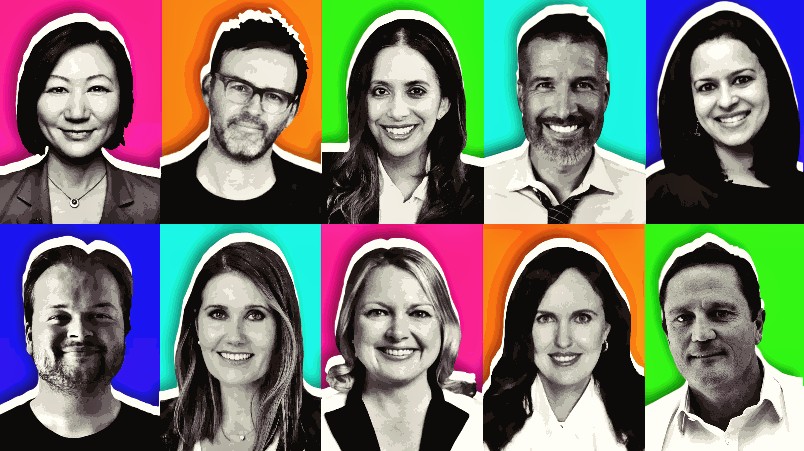
Massive personalisation at scale; wholesale CX overhauls; martech switch-outs; porn star martinis; huge customer remits; 80,000 ad variants; deploying a holdco’s 100,000 workers using an AI hive mind; in-housing properly; reorganising a bank’s media spend around owned media; halving ad carbon emissions by culling adtech supply chains; linking brand investment directly to sales; de-coupling from Google; generative AI’s impact on search and content strategies; double duty on brand versus demand; copying the marketing effectiveness rulebook word for word and winning the biggest budgets in company history and much, much more. Mi3’s top podcasts are deep, wide-ranging and durable. Even the sponsored ones are genuinely good. More than 24 hours worth of insight and occasional humour from smart people at the sharpest end of marketing, media, tech and consulting – bookmark this one, dip in at leisure and genuinely learn from some of the best in the business.
30.

Digital burnout, ad blindness and sick of brands talking purpose: The 5 million Australians marketers risk alienating – and how to make them share your Out-of-Home campaigns
Gen Z makes up 20 per cent of Australia’s population. There are more than five million of them – and they want very different things from brands. Purpose won’t cut it. They want action, locally and globally – and they are sick of nobody listening to them, per Chris Sanderson and Martin Raymond, founders of The Future Laboratory. They are also – aged between 11 and 26 – already wary of digital burnout. They’ve been bombarded with digital content their whole lives. Which means many are blind to the ads they’ve not already blocked. But not Out-of-Home: Out-of-Home is “so important for them [and to reach them] because Gen Z don’t see it as an intrusion,” per Sanderson. “They see it as a logical, seamless connection with their world of brand.” They are also making their purchase decisions in very different ways to previous generations – the pyramid and related funnel are now “circular”, reckons Raymond, with profound impacts for brands. Plus they say its time to stop “sneering” at the notion of crowd-sourcing aspects of ad campaigns – or at least getting far broader inputs, particularly when marketing on billboards, because Gen Z is all about community, collaboration, and commitment: “It guarantees the sharing of the campaign,” says Raymond. Off the back of a deep dive commissioned by JCDecaux, the two unpack what brands need to know about marketing to Gen Z in this sponsored Market Voice podcast.
29.

Bridging the creative-tech-culture divide (l to r): Seven CMO Mel Hopkins, SXSW Sydney MD, Colin Andrews, Seven CRO Kurt Burnette.
'We’re going all in’: SXSW’s biggest tribes are brands, marketing, tech as Sydney gig aims for Southern hemisphere creative, innovation super event; Seven plots biggest overhaul of Upfronts format in decades with full-week SXSW program
Uber launched at South by Southwest, as did Twitter, Pinterest and Foursquare. Billie Eilish was discovered as an unsigned 14-year old. Mumford & Sons first made their name at the creative-tech-culture jamboree in Austin, Texas. But could the powerhouse event replicate itself outside of the Lone Star State? Three months out, SXSW Sydney MD, Colin Daniels, was backing Sin City to deliver – with the likes of futurist Amy Webb, Coachella co-founder Paul Tollet and Slack co-founder Cal Henderson joining “titans of every industry” across tech and innovation, music, games and screens. Per Daniels, every one of its 70 featured speakers would likely be the keynote at any other event. No wonder that circa 500 brands were clamouring to get involved – and precisely one of the reasons Seven West Media went large, partnering with SXSW Sydney and planning a very different kind of upfront during the week-long festival. Chief Revenue Officer, Kurt Burnette, said getting the investment over the line was a “difficult conversation”, but backed the play to position the network at the heart of the creative-tech nexus and change perceptions. CMO Mel Hopkins was tasked with shaping exactly what that looks like. No pressure then...
28.

Pump up the volume – and the creative quality – or fail. L to R: Accenture Song ANZ President, Mark Green; Tabcorp Data & Analytics Chief, Amy Shi-Nash; Accenture Song Creative Chairperson, Nick Law; ANZ CMO, Suzana Ristevski.
‘No hallucinations’: NAB, Tabcorp, Accenture Song on 'applied AI’ - less ‘possible', more ‘pragmatic’ use cases first; NAB flags AI creative surge for 500m personalised messages but brands warned on mindless messaging, CX usurping media for brand building
NAB CMO Suzana Ristevski is a touch emphatic after just completing a three-year, $45m grinding overhaul of the bank's marketing technology systems that has seen 95 per cent of the tools used by the marketing team switched out – a Pega decisioning engine and Tealium's customer data platform are among the new line-up. Now NAB is ready for the AI stuff. Ristevski acknowledges “inflicting a lot of pain” on the bank’s marketing team in the tech transformation and there’s more to come but it's "more exciting" as NAB works to embed machine learning and generative AI to deliver personalisation at scale that isn’t just “sending out rubbish”. She’s already sent out 10x more comms, now circling at 500m. But the bank is acutely aware of the risks posed by AI – and the strategy goes all the way up to the top. Tabcorp is onto its third in-house generative AI program and the creation of a centralised unit, Next Labs, to experiment – the problem with the other two was that they lied, or suffered “hallucinations”, per Chief Data & Analytics Officer Amy Shi-Nash. But Tabcorp can’t risk plugging into things like ChatGPT. The Monkeys and Accenture Song ANZ boss Mark Green, meanwhile, is back from Cannes where the AI banter was redlining on a "moral crisis" crisis for creativity, not dissimilar to the previous metaverse hype cycle. Green’s not worried. He reckons he’s slipped Accenture Song Global Creative Chair Nick Law an idea “that’s as good as any we’ve ever created” with generative AI at its core – and he says the client briefs are coming in from all angles. New York-based Law thinks there are new AI risks which will undermine the fascination and effectiveness of personalisation – namely, tonnes of mediocre messaging that will be created under the guise of 'right person, right time', unleashing a sea of sameness. NAB's Ristevski agrees.
27.

Norths Collective's Rob Lopez: "It used to be very one way: Quarterly, we'd sit down with all of our partners, and they'd say, ‘this is what you've done in the last quarter’. Whereas now we're running that discussion. We're presenting data back."
'Ethical personalisation’: How a leading CX, martech convert at Norths Collective is (finally) proving ROI on tech stack investment, not just campaigns; engagement rates rocketing over global norms; Lion hungry to tap its member app and loyalty program
Ask any marketer with CX and martech in their remit to prove the return on those investments and it can get a little awkward. But CFOs are increasingly asking the same question. Here’s a full and frank download from a marketer doing exactly that: assessing ROI on its customer experience strategy – on and offline – after going all in on Salesforce, just before the pandemic hit. Rob Lopez, GM of CX, Brand and Innovation at Norths Collective, which operates eight venues and clubs and two fitness centres across Sydney, has embarked on "Project ROI" to quantify its contribution to profit. Lopez already knows the transformation is working: engagement rates are through the roof thanks to what he calls “ethical personalisation” and the firm is able to attribute comms output to member action, digitally at least. Now it is digitising memberships to better understand offline – or in-venue – activity. The kind of insights it is delivering to the likes of Lion has the drinks giant smacking its lips to get inside the new app. Meanwhile, smarter data and analytics capability means Norths is de-risking its next phase of growth – because it knows the dollar value existing members can bring to new venues “before we even open the door”. Lopez has five tips for marketers embarking on (or rethinking) their digital transformation strategies.
26.

Marketing holds: “Nine believes in marketing-led growth...to continue to attract the audiences that we do today or to grow them into the future, investment into things like marketing into content and into technology are important,” says CMO Liana Dubois.
Stack wars – a new hope: Nine’s first Group CMO Liana Dubois says Nine consolidating martech, restructuring marketing in bid for growth, but budget ‘safe’; relishes competitive clash with former Optus turned Seven CMO Mel Hopkins
After five years of mergers and acquisitions, Nine’s first Group CMO Liana Dubois has hinted at an incoming major brand offensive as the former boss of the media group’s Powered division says the network will walk the talk on creativity. Dubois says Nine has now de-siloed its marketing operation, the next surgical intervention is a major review of its disparate tech stack. While Nine’s latest results suggest cost efficiency is the name of the game across the business, Dubois says CEO Mike Sneesby is a "big believer in marketing-led growth". Perhaps her budget is safe for now. Either way, she says Nine has plenty of scale to harness across its vast owned assets, though how Australia’s data-privacy overhaul ultimately crimps those plans remains to be seen. Meanwhile, with former Optus CMO Mel Hopkins now Dubois’ opposite number at Seven, a new competitive tension is brewing as the networks battle shifting audience consumption and buyers holding out to see which way the chips fall. Dubois says it will be good for the category.
25.

24.

Me&u CEO Katrina Barry says the future of her start-up will be "a data and insights business...Hospitality is not an industry that has fully embraced quantitative analytics."
'Dark bars', A-list investors and the rise of 'pornstar martinis': How Australia’s top tech female leader Katrina Barry is chasing $250bn, crunching bar and pub business models with more tech, less humans and much happier, higher-spending customers
Katrina Barry is Deloitte Tech's Fast 50 female leadership winner for 2022 and CEO of the globally ambitious Australian restaurant and pubs ordering app Me&u, backed by a Hollywood-style list of Australian names including Merivale’s Justin Hemmes, Rockpool's Neil Perry, Uber Australia co-founder Mike Abbott and former Google ANZ and current Domain boss Jason Pellegrino. After successful stints at McKinsey, Virgin Group and Contiki – and a less than enjoyable "straighty one-eighty" corporate gig in financial services – Barry's about a year into the role. Me&u already controls about 70 per cent of large format hospitality venues in Australia and is now going global. Barry argues the little round device on bar and food tables is actually about business transformation, customer experience and, for venues, at least 30 per cent more business per bill if they don't have to wait for a negroni or a kale infused pheasant at the counter – or for a host. Hence, many venues are now creating 'dark bars' as one tactic to improve customer experience and sales. Here’s why a little bit of tech in a pub or restaurant is transforming the economics of the hospitality sector – and customer happiness.
23.

Fully charged: Volvo Car Australia MD Stephen Connor is backing Marketing Director Julie Hutchinson to go hard on brand in bid to win the electric vehicle race as consumer demand – and ad market – heats up. But there's big structural change ahead.
‘The race is on’: Volvo boss Stephen Connor on why going all electric by 2026 will double sales, protect revenue – but poses tricky challenge for marketing, even with bigger budget as EV ad spend triples
Volvo Car Australia boss Stephen Connor has hit the accelerator on the carmaker’s plan to ditch combustion engines. He’s going all-in on electric vehicles (EVs) by 2026 – faster than any of its global markets. Volvo has deep sustainability commitments, pledging to become climate neutral across its supply chain by 2040. But Connor’s gone for first mover advantage for profit just as much as purpose, because by 2030 “every manufacturer in Australia will be standing on the mountain beating their chests about EVs”. By then, the market will be awash with technologically advanced electric cars. Hence Connor thinks brand will become the key differentiator – and he’s backing Marketing Director Julie Hutchinson to ensure Volvo builds a greater share of mind. "The race is already on," she says, with EV ad spend tripling last year. But the sprint to all-electric cars means major change ahead for dealers and retail operations (Volvo is about to launch an online sales play) while a rapid rollout of new electric models requires new business models – including subscriptions – to scoop a new cohort of younger buyers. Here’s the plan.
22.
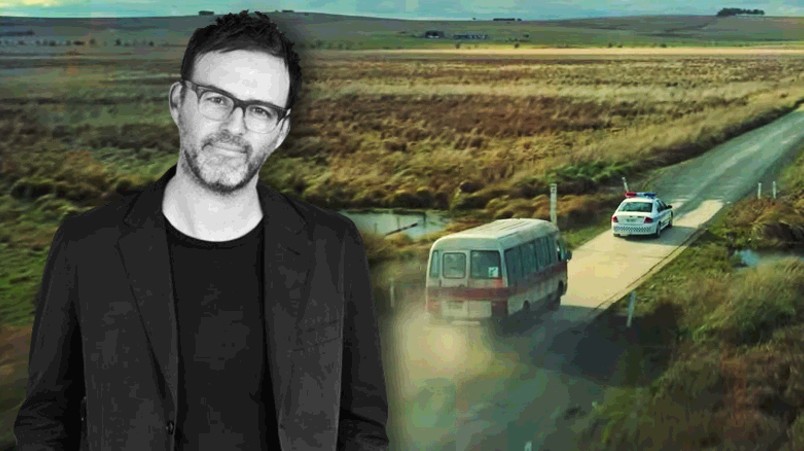
Brent Smart: "Hope is the worst strategy. You need a plan for how you're actually going to get there." He's got several – and they are all starting to converge.
‘It’s sharpened me up as a marketer’: Telstra CMO Brent Smart bids to link CX and rising NPS for non-believers, flip performance and brand investment ratios and systemise marketing team creativity, attention and MMM
While Telstra’s massive CX overhaul has powered net promoter scores through the roof – with NPS linked directly to executive bonuses – CMO Brent Smart says that’s only half the job. To grow, Telstra needs to go harder on brand to woo those that don’t even know about its sweeping digital overhaul, including aggrieved former customers. As such Telstra’s 80:20 performance to brand investment ratios won’t stay that way, but Smart says competing with the likes of JB HiFi and Harvey Norman plus rival telcos in the monthly acquisition battle royale “has really sharpened me up as a marketer.” Smart thinks too many firms are failing to properly link brand communications through to CX and performance, using the same off the shelf tools and “luggage matching” instead of truly being fit for platform. Meanwhile, he’s testing performance channels to gauge if they are delivering incremental growth versus sales that would have happened anyway – and similar tests at IAG threw up some interesting results. Plus, Smart and Telstra are diving deeper into market mix modelling while building out a framework across the marketing function to “systemise and quantify” great creative work “without strangling it”. The latter is lifted from AB InBev’s award-winning template, the former an attempt to demonstrate how marketing investment is delivering ROI and contributing to the bottom line. Between the two “I’d be lying if I said we could predict the impact of better creative,” per Smart. But in terms of media planning, he’s going all out for attention. “That definitely does change your channel choices,” says Smart – and there are winners and losers. Smart also fires back crisply at those suggesting Telstra’s new brand ad is lacking in branding, and unpacks the thinking behind new bespoke agency, +61.
21.

Lion’s ex-CMO, now Chief Growth Officer trailblazes with company-wide IT budgets and strategy, M&A, marketing and innovation agenda; Anubha Sahasrabuddhe sets 500-day target to flip IT culture to customers
Tectonic movement is reshaping blue chip marketing with remits expanding by the day. Coles and IAG replaced the CMO role with Chief Customer officers. ANZ CMO Sweta Mehra was earlier this year promoted to Managing Director of ANZ’s Everyday Banking business. But Lion’s latest move tops the lot for adventure. Anubha Sahasrabuddhe in February became Chief Growth Officer at the $3bn drinks firm. The former Mars global marketing chief has responsibility for marketing, M&A plus enterprise-wide transformational innovation beyond new product development. Just to make things more interesting she’s also been handed responsibility for IT and technology. Which means the CMO is now effectively CTO, CIO and CDO to boot. Lion CEO Sam Fischer, former APAC chief at Diageo, is backing Sahasrabuddhe to deliver. She’s given herself and her team 500 days to move the needle and reengineer the company’s culture, including IT, entirely around the customer. “If we can't demonstrate sufficient progress, then we can't justify our existence,” says Sahasrabuddhe. “The days are ticking.” This podcast is as wide-ranging as the remit. Tuck in.
20.

Dream flight: How Virgin’s decimated marketing team launched an automated creative campaign with 80,000 'full funnel' ad variants, lifted revenues 30% but... brands will cede more control to Google, Meta under new privacy regime
The killer combination of Covid and voluntary administration decimated Virgin Australia’s marketing team to a handful but under its new private equity owners, Bain Capital, Virgin’s head of paid media, Ben Will, finally got to deploy a massively scaled and personalised programmatic ad campaign that he had been dreaming about for years. But it nearly broke the Virgin team and its media and dynamic creative partners at PHD and Adylic in the process. It took months after launch to fine tune but they survived, ultimately lifted revenues 30 per cent and landed the MFA’s top award for real-time marketing for their efforts. But Will is worried new privacy laws will hand much of the control he currently has to "test and learn" to the walled gardens like Google and Meta, where their unknown tools and AI do all the optimisation without any visibility for advertisers.
19.

Same budget, more work - Treasury Wine's in-house team at Splash (L-R): Ben Oliver, Senior Manager, Digital Media; Phil van Bruchem, Creative Director; Tom Opie, Creative Director; Elsa Beaumont, Director and Faye Collay, Head of Operations
Penfolds-Treasury Wines lauds creative, media together for its in-house agency Splash, now going global: 20 people, 400 projects, same marketing budget but doing more, better, faster – mostly
When Elsa Beaumont was tapped last year by Treasury Wines Estate – home of the mighty Penfolds – the former exec at global hot shops like Mother and Big Spaceship, and her colleague Ben Oliver, who’s running Treasury’s internal media unit at Splash, were worried. Could they beat all the warnings that come from agencies when brands try to go in-house with capabilities all previously outsourced: talent is hard to attract and keep stimulated, burnout is a high risk and any cost benefits would be short-lived. Burnout risk turned out to be true but the talent, quality and volume of work is rocking, they say – and now Splash is preparing for a global rollout across Treasury Wines’ international markets. The upside is faster turnarounds, tighter links with marketing teams and better output than what was possible by just using agencies. And in the case of media, Oliver is chasing down transparent digital media buys and practices that he never quite got in life before Splash.
18.

ANZ CMO Sweta Mehra: ‘There’s only so far you can go with paid media’ – why ANZ is investing heavily in owned media assets; 85 million impacts a month across ANZ channels triggered a ‘mindset shift’ for marketing team
After ANZ CMO Sweta Mehra commissioned owned media specialists Sonder to conduct a valuation and audit of the media assets the bank owned and managed, her big discovery was that circa 85 million impacts a month, mostly from ANZ customers, were under-leveraged by the business. Now ANZ’s marketing team think first about their owned channels before developing paid media briefs. New content hubs coupled with ANZ’s two year investment overhauling its tech and personalisation capabilities, for example, has seen “up to a tripling of conversion rates”, says Mehra. Sonder Co-Founder Jonathan Hopkins says ANZ also has a big upside in acquiring new customers from its owned media assets, not just better cross-selling of products to existing customers. "ANZ have screens outward facing in most branches around the country – in some cases they can also do customer acquisition," says Hopkins in this sponsored Market Voice podcast.
17.
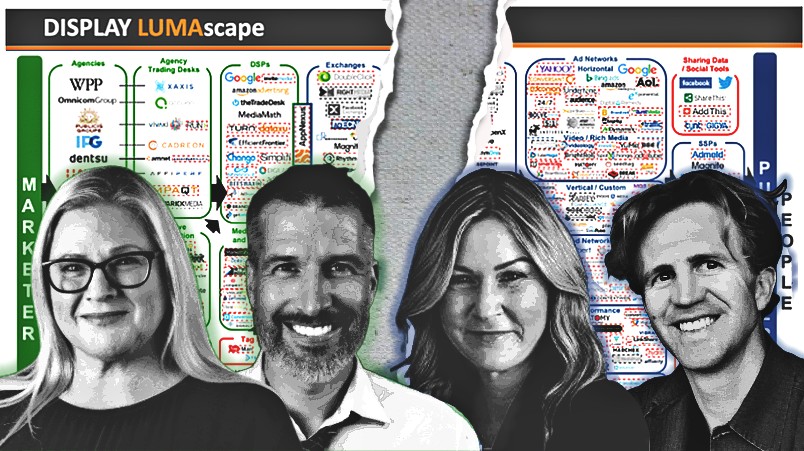
"Realistically, we could decarbonise programmatic at least 50 per cent in twelve months," reckons Brian O'Kelley, but marketers must drive it. AMI's Bronwyn Powell (left), Suncorp's Mim Haysom (centre right) & NAB's Tom Dobson (right) ask the questions.
Halve digital ad emissions in 12 months by culling adtech, binning outstream ads, swapping viewability for attention metrics and flicking junk ad inventory, says Scope 3’s Brian O’Kelley: Suncorp, NAB and AMI ask the curly questions
There’s an easy way to cut carbon emissions from digital advertising. Stop buying “crap” ads that “no human sees”, ditch “gamed” viewability metrics and instead buy on attention, never buy another outstream video ad, and cull the bloated programmatic supply chain, per Brian O’Kelley. The CEO of Scope3, a global emissions measurement firm focusing on decarbonising digital media and advertising, knows how much waste lurks within that supply chain – the sprawling Lumascape – because he was in deep and early, founding AppNexus, which ultimately sold to AT&T for $1.7bn. Even “turning off five to seven per cent of inventory gets you a 29 or 30 per cent reduction in carbon,” says O’Kelley. Publishers feeling the heat to decarbonise – GroupM and Mediabrands are talking about money moving next year – needn’t fear. He reckons they will see more cents in the ad dollar as the bad actors get punted. Marketers will also stop wasting billions of ad dollars while saving millions of tonnes of carbon. But marketers have to lead, because everyone else will follow the money. Suncorp CMO Mim Haysom, NAB’s Operations, Planning & Partnerships lead, Tom Dobson, and Australian Marketing Institute CEO, Bronwyn Powell join Mi3 to ask the pointy questions on where next – and how fast.
16.

15.

High pressure: Scire CEO Chris Janz and Guardian Australia MD Dan Stinton say trust issues, privacy regulation and the economics of chasing scale in a changed digital game present multiple storm fronts for Australian news media.
‘No personal data’: Chasing audience scale, ad exchanges, big tech targeting is publisher folly as media trust plummets, says Scire’s Chris Janz, Guardian’s Dan Stinton; No-tracking, contextual ads next growth wave
If Nine’s former publishing boss Chris Janz and The Guardian’s former Managing Director Dan Stinton are right, there’s a storm brewing for the media establishment as frustration rises among the business, tech and innovation elite – and even the broader public – over what and how mastheads and journalists produce content. Chris Janz did the “deal of a career” when brokering the 2017 ‘unholy’ alliance with Google to sell Fairfax’s premium ads and audiences programmatically, reportedly for guaranteed annual revenues north of $40m. Now Janz has flipped entirely with VC-backed media challenger Scire: He says Scire won’t collect any personal data at all and thinks those relying on Facebook and Google for traffic, while trying to compete on data and tracking – areas in which News Corp, Nine and others have invested heavily – “are playing someone else’s game” and have already lost. The future of mastheads, he says, is all about trust and serving smaller, smarter segments with content they will, in some way, pay for. Either way, privacy regime changes will soon disrupt tracking-based ad-funded business models – and Scire isn’t going to do traditional advertising at all, per Janz. Outgoing Guardian Australia MD, Dan Stinton, agrees on trust, contextual targeting and the push away from open exchange “direct response” advertising. The Guardian has slashed its reliance on open ad exchanges from half to a tenth of its ad business in five years under Stinton – reader contributions now make up more than half of revenues but ads are still growing at a fast clip. Stinton and Janz unleash on the new challenges facing the media establishment and the full force of AI scrape and lifts that are about to hit.
14.

Yahoo’s new team, new mission: Yahoo Australia execs unpack the global restructure and the “why and what” of a new, simplified game plan
There’s been just a little happening inside the $8 billion Yahoo business globally – and in Australia. The digital content and advertising business announced at the start of the year it would reduce its total workforce by 20 per cent but global CEO Jim Lanzone told Axios the layoffs were not about financial challenges. Rather it was an important strategic change. No longer is Yahoo pushing a “unified tech stack” to compete with Google or Meta. “We really had to take a hard look at the business and make the big decision to refocus and prioritise where we really succeed the most,” says John McNerney, who subsequently took the helm for Yahoo across Australia and Southeast Asia. “It was nothing to do with financial challenges or troubles in the advertising market but really instead about a strategic restructuring and refocus globally for long term success. We were trying to be the masters of everything, building a unified tech platform with DSPs and SSPs to compete against Google and Meta but we realised change was needed.” The firm outlined its simplified game plan in this sponsored Market Voice podcast.
13.

SCA pushes back on media agencies driving carbon agenda, eyes bigger slice of TV budgets for audio as inflation rises, reach tails off – and FMCG advertisers are getting the message
At the start of the year, Southern Cross Austereo's then Chief Sales Officer Brian Gallagher had some contrarian views on the big push from agency groups to have media owners meet ESG and carbon neutral benchmarks as part of their annual ad deal negotiations. He also argued media buyers might be a little lost in the haze of numbers when audio platforms like Spotify bundle overall podcast audience numbers, which include SCA shows that Spotify can't commercialise. Gallagher scotched a widespread misconception that they can. On the flip side, SCA's then Head of Ad Product, Jonathan Mandel. is buoyed by the continuing surge of digital audio listening. At a market level, 9.4 million people are tuning in every week into the digital channel – the same number as broadcaster BVOD audiences. Mandel sees major reach gains for advertisers that take a slice of TV budgets: “If you're investing into a BVOD campaign, the studies we have developed show that if you put 15 per cent of that budget into digital audio, you can increase your reach and the overall reach curve by an additional 40 per cent.” Gallagher said the message is landing: “We've got FMCG advertisers onboard that have never advertised on radio before. I’m talking seven-figure commitments.” A sponsored Market Voice podcast that still resonates after an interesting year for SCA.
12.

Major changes to Google Analytics as a result of privacy shifts are causing corporate compliance and marketer pain. L to r: Matomo's Dion Blair, Jason Elk, Piano's Marie Fenner, Indago Digital's Gary Nissim, Rank Robin's Charlie Penwarden.
Cookies again? Google’s global hegemony measuring 100m-plus websites faltering amid corporate governance concerns in privacy, data ownership; Brands, tech, advisors weigh-in on measurement meltdown
Tightening privacy regimes around the world have pressured Google to change the way it tracks and measures web traffic across the majority of the globe’s estimated 100m sites on the open web. That forced Universal Analytics to be swapped out in July for an entirely new product knowns as GA4. The problem is it’s a mess for most. And it's a likely marker for what’s to come in Australia – companies in Europe, and even the US, are pulling out of Google's near-ubiquitous [and once free] analytics platform as marketers fumble with new tools, unable to quickly pull key reports, historical comparisons and insights. Many are raging against the big Google data-swiping machine as European regulators enforcing stricter rules on how people’s data is used, stored and transferred, dishing out big fines over GDPR breaches. Some of the big questions hovering over Google’s new analytics products include whether they’re fully privacy compliant, particularly if Google is feeding its vast global advertising business via sample data carved out from website owner data, most of whom are only now discovering they don’t own or often see all their real audience behaviour. In France, about 80 per cent have reviewed their analytics, per Piano’s global analytics chief Marie Fenner, and “about 60 per cent” have switched". That scenario may soon repeat in Australia as data privacy rules are beefed-up. Scentre Group performance marketing lead Jason Elk thinks the shake-up threatens Google’s analytics dominance and by proxy its broader business. Matomo CRO Dion Blair, agrees. “Right now, unlike any time in the past 15 years, we're seeing the choice [businesses are making for analytics] is potentially not the big behemoth.” Here’s what marketers locally and globally now face.
11.

How AI is hitting paid search, content strategies; where prices are headed; why Google is changing its LTV tune; and why interpreting media mix modelling requires human intelligence
Search and SEO is facing major disruption – with implications for brands across both performance media and mid-to-upper funnel content marketing. Google is countering the threat from Bing and ChatGPT under Project Magi (and latterly via Gemini). Billed as a “hyper-personalisation engine”, it will change how search works and the way content on websites needs to be written and structured, per Stephen Downward, Head of SEO at Atomic 212°. That’s on top of Google algorithm changes that call time on the days of 500 word blogs and average content. The key to ranking and traffic is now all about EAT: Expertise, Authority, and Trust – plus Google has added another E: Experience, which is why News Corp, alongside Atomic, created a vast trove of articles via masthead financial journalists to feed its new comparison site and take on Finder, says Downward. Within paid search, prices will continue to climb, per Atomic Head of Performance Media Sascha Bonomally, which is why Google’s new rhetoric is around amortising the cost of its upfront click to lifetime value. Either way, Bonomally thinks advertisers now optimising clicks to products with best margin are making a mistake. A sponsored Market Voice podcast that will prove instructive as generative AI rechapes the digital landscape.
10.

The future of total TV: Voz, the cross-network ‘BVOD Project’, Unilever’s 20 per cent reach gains and converged trading implications for marketers, agencies and TV networks
With Voz in market and the TV networks seemingly moving forward with a BVOD marketplace, agencies and broadcasters have renewed impetus to converge TV trading and buying and flick legacy systems. But ditching decades of behaviour is never easy. Perhaps the best example is what has been dubbed the Unilever trial, where the FMCG giant, agency PHD and Seven West Media used early Voz data to boost reach by 20 per cent while cutting audience duplication to four per cent by combining linear and BVOD. Alex Tansley, Head of Converged Audience Trading at Seven and PHD investment chief Joanna Barnes were key architects of that trial. In this sponsored Market Voice podcast, they unpack what converged TV trading will look like in the next 12 months – and what that means for marketers, media agencies, TV networks and perhaps ultimately the pure-play streaming platforms now entering the advertising game.
9.
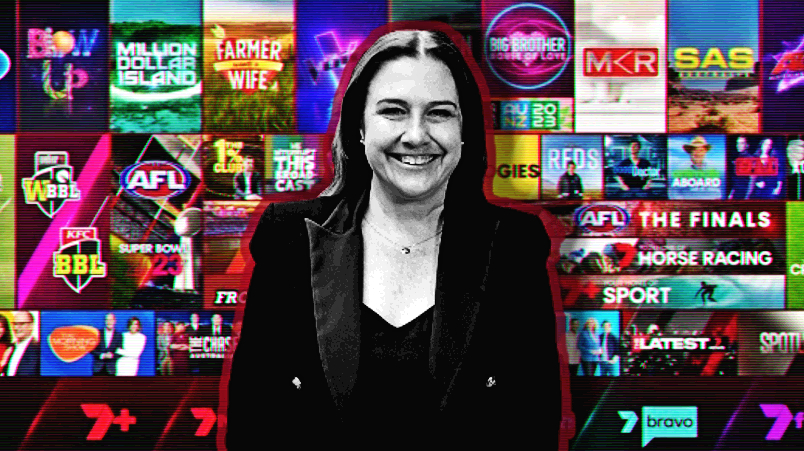
Seven marketing and audience chief Mel Hopkins: Brand investment can turn TV's audience fortunes around and drive earnings growth – but there's a transformation job ahead to see off the streamers.
Why Mel Hopkins left Optus for Seven CMO gig: Not putting 'lipstick on a pig’; Big transformation plan looms – sharpening marketing, hitching it to the P&L – and her take on the Optus cyber attack
Mel Hopkins didn't go to Seven “to put lipstick on a pig”. The former Optus CMO says CEO James Warburton wants “total transformation” – and not just across ratings – and she’s hatched a four-point plan. Hopkins has also committed to linking Seven’s marketing activity and investment directly to earnings and the P&L “in real time”. Anything less, “and I am failing to do my job”. That means growing both the brand and its equity as well the number of eyeballs tuning in as a destination – fast. Hopkins thinks Seven, particularly Seven Plus, can outpoint the streamers and reckons their ad-funded tiers may fizzle out as Covid-driven growth wanes. But just as Hopkins is finding media an entirely different world to telco – it’s way more complex than she realised – she says Seven’s media-focused marketing team must also “sharpen up” when it comes to “strategic marketing and advanced digital marketing”. Plus, Hopkins opens up on the Optus data hack, not sleeping for five weeks, but why living through the experience, in all probability, will pay off.
8.

L-R: OMA's Grant Guesdon; Avenue C's Pia Coyle and Neuro-Insight's Peter Pynta: "Media owners are a little bit hesitant to work out how this should be applied, if at all, on their end," says Coyle. Pic: Illustration: Lauren Martin
Mexican standoff: Out-Of-Home sector hits agency slow lane on take-up for neuro impact versus attention metrics; Avenue C’s Pia Coyle implores buyers and sellers to get over pricing fear paralysis
Attention measurement has captured much of the ad industry’s focus in the past two years just as the out-of-home industry body, OMA, was well into its roadmap to apply a “Neuro Impact Factor” to thousands of individual digital and static screens. Neuro-Insight, the firm behind the measurement system, has among the most robust, academically peer-reviewed advertising science worldwide – initially developed by Professor Richard Silberstein and neuroscientists at Swinburne University’s Brain Sciences Institute to understand brain behaviour among ADD and ADHD children. Despite the science – real advertising science as its proponents argue – media agencies are dragging the chain on take-up, certainly versus emerging and scaled attention metrics. But here’s why the industry needs both and what should happen next according to Avenue C's Pia Coyle, Neuro-Insight’s Peter Pynta and the OMA’s Grant Guesdon.
7.

Full service: Mycar CCO Adele Coswello and TBWA CEO Paul Bradbury.
From CFO to Chief Customer Officer: How a Wesfarmers exec handbraked finance career to become mycar’s CCO, dumped and relaunched a new brand and end-to-end CX remap – using a reinvented creative agency for CX and media
A former Wesfarmers CFO, of all people, led the cull of the Kmart Tyre & Auto brand after 50 years in market but took on the challenge to rebuild as mycar's Chief Customer Officer, tasking a creative agency, TBWA, with full service CX, media and brand transformation. It worked: sales are up 23 per cent, at least since 2020. Now under Adele Coswello mycar is positioning for another major transition – electric vehicles – while bidding to steal share from free-spending pure-play rivals such as Bob Jane T-Marts and Ultra Tune. It's dropped a retail, up-sell focus and gone all out for 'people first’ and building pop-up stores next to shopping centres, putting vans on the road to deliver mobile services, while putting tech into its garages that give customers a stream of their cars' vital signs – and what's being done to keep them healthy. Meanwhile TBWA chief Paul Bradbury says moving into CX and media and taking on the consulting giants is the shape of things to come.
6.

Art, analytics and ideas: Deloitte Digital's Global head Sam Roddick and Global Commerce and Marketing Practice Lead Nick Garrett. "It turns out that it's pretty hard to blend creativity with technology," says Roddick.
‘I’ve never made a client cry’: Deloitte Digital Global CEO Sam Roddick’s mission with ex-ad agency boss Nick Garrett to copy Apple’s creativity, design and engineering for digital restructuring programs – and why the ‘majority’ still fail
During a high-level pitch to the CEO of a leading but unnamed global consumer packaged goods firm hunting 25 per cent growth in a mature category, “the eyes lit up” at the combined code, creative and culture components being proposed by the “cold, hard analytical” consulting firm Deloitte Digital, as Global CEO Sam Roddick recounts. The pitch involved a top Deloitte Digital team unveiling the blueprint for a new direct-to-consumer (DTC) business unit to deliver on the CEO’s ambitious growth remit. Roddick hopes it’s a benchmark project in-the-making as his firm accelerates to “mimic” Apple-like design and creative capabilities with engineering and systems prowess. The new ‘X’ factor for Deloitte Digital though is the nod to creativity and the business contribution it makes as a “value multiplier” for its industrial-grade customers. Part of Roddick’s global plan to help institutionalise creative thinking in the $16bn firm involves a former BBDO ad agency network CEO in Australia and New Zealand, Nick Garrett. But can the “cold, hard, analytical” firm really pull this one off?
5.

L-R: Hipages Marketing VP Nick Ellery and Chief Customer Officer Stuart Tucker. “The missing piece moving forward for us is the mid-funnel, which is actually all around content,” says Ellery.
‘Meteoric rise’: How tradie platform Hipages halved paid search and customer acquisition costs after brand investment; next a review of Nine’s The Block, upswing for content marketing, click rate optimisation, tech stack overhaul and…impress investors
Hipages Chief Customer Officer Stuart Tucker and VP of Marketing Nick Ellery say growing an online marketplace requires an entirely new suite of marketing and media capabilities to create and match demand and supply between households needing a tradesperson and tradies needing work – and it’s loaded with tension. They’ve got to build a B2C and B2B brand simultaneously and mange short-term demand volumes for two completely different customer sets in real time down to postcode level. That means more sophisticated data feeds to inform fast direct response media channel tactics like paid search when plumbers need work in Melbourne’s Hawthorn next week or household demand for sparkies in Sydney’s Hornsby is surging today. They’re quickly mastering brand and performance levers together and now adding to the “mid-funnel” with content. Here’s what Hipages is doing next after a three-year “transformational” investment building its brand that has slashed the reliance on paid search for new customers – although it remains a leading tactical strategy for the business.
4.
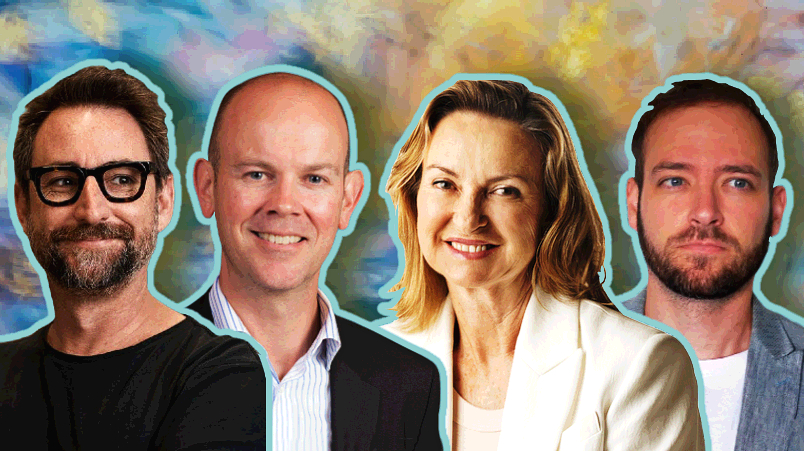
L-R: James Hurman, Rob Brittain, Pippa Leary and John James: "What gets lost here is people trying to split these things into channels – it’s really not a channel discussion. It’s how you use the channel, what message you use," says John James.
Double duty dilemma: Can a search or social ad build brand and drive sales now? Media execs, reformed growth hackers and ad effectiveness maestros duke it out – as ESOV critics have their say
Debate on whether brand campaigns can drive short term sales performance and vice versa – aka ‘double duty’ – is running as hot as the budget knives pressed to the CFO’s whetstone. News Corp’s Pippa Leary says market-wide short-termism is fuelling demand for performance ads to drive immediate results but double duty works – results for Moet has LVMH marketers popping their corks. Brand strategist James Hurman says brand campaigns can drive short-term sales, but that trying to make one ad to do both is “way harder” than just making two ads, so why try? Either way, using the same metrics for brand building and short-term sales “is like judging a fish by its ability to climb a tree,” per Hurman, “it’s always going to be a shit fish”. Rob Brittain says marketers only have themselves to blame: Few can articulate the difference between the two – nor why long and short need to work together – to CFOs under pressure for short-term sales. Meanwhile, he says marketers are getting the basics of ESOV wrong, ending up closer to double jeopardy than “difficult” to achieve double duty by wasting money on low attention channels. But partially reformed growth hacker turned growth advisor to companies up to $100m in revenues, John James, thinks ESOV is a flawed concept based on touting the benefits of being “the loudest person in the room” by those who “want to sell more advertising media to clients”. He also throws a jab or two at Ehrenberg-Bass ‘how brands grow’ thinking. Brittain can’t let either go unanswered. This one gets politely punchy.
3.
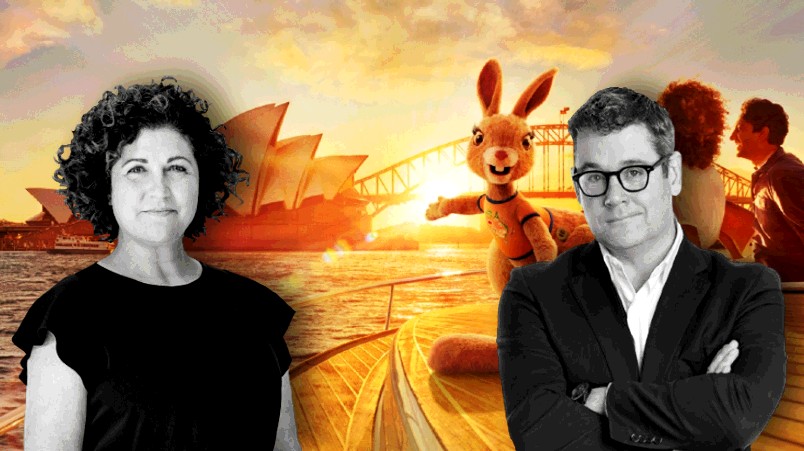
Unmistakably Australia: Susan Coghill and Mark Ritson on why Ruby the kangaroo is moving the marketing effectiveness needle, building brand and demand – and confounding critics – for years to come.
Let the marketing effectiveness rulebook do the talking: Tourism Australia CMO Susan Coghill and Mark Ritson on why Say G’Day’s success has silenced doubters – and will keep rolling for years
The naysayers scoffed when Tourism Australia made a CGI Kangaroo and 1984’s Say G’Day tagline the main roll of a $125m tax-funded bet to bring the world back to Australia after three years of fire and plague. One year on, those “doofuses” are eating their words, per Mark Ritson, as the kangaroo eliminates misattribution, boosts consideration, delivers travellers in droves, primes high spending tourists to plan trips for next year and beyond, and remains at the very top end of System1’s effectiveness league table. Funnily enough, say Ritson and Tourism Australia CMO, Susan Coghill, following the marketing effectiveness playbook actually works – and the armchair critics were never the intended target. While Tourism Australia is now heading into a statutory review of its creative agency roster, don’t expect much to change platform-wise – which means more budget to keep hammering the message home, building brand and delivering demand. Ritson reckons it could run for 20 years without wearing out. Coghill’s planning for at least four. Here’s how Coghill did her homework, sold it in to stakeholders, went to market and how it’s tracking – and why, per Ritson, 20-30 per cent of marketers will never make the top grade because they cannot get comfortable with imperfect marketing datasets.
2.

Raising brand equity stakes: Mutinex's Henry Innis (left) and Tracksuit's Connor Archbold.
Brand equity blow-up: Ritson-backed Tracksuit eyes $8bn brand tracking market, Ipsos, Kantar, Nielsen disruption by linking brand equity directly to P&L; inks Mutinex deal
Here’s how two firms in different parts of the supply chain are upending legacy marketing practices. Tracksuit, a two year-old New Zealand-based brand tracking platform has slashed the cost, turnaround time, cred, and the role of brand – historically considered fluffy by the business community. The rapidly growing start-up has caught the eye of VC Blackbird, with Mark Ritson and Ascential, the firm behind Warc and Cannes Lions, also investors. Now it’s bidding to carve out a major slice of a market dominated by big global research firms like Ipsos, Kantar and Nielsen – and has just struck a partnership with fellow SaaS disruptor Mutinex. The two aim to align the in-market perceptions of a brand directly to the P&L while doubling the $4bn addressable brand tracking market. Crucially, the hardcore VC types are piling in not just as investors, but for their early stage startup investments to actually harness the tech to grow faster and more sustainably as growth hacking bites the dust and startups flip to brand investment that, amid far more sober money markets, must be quantified in hard financial terms. Tracksuit co-founder Connor Archbold and Mutinex CEO Henry Innis join Paul McIntyre on the mics.
1.
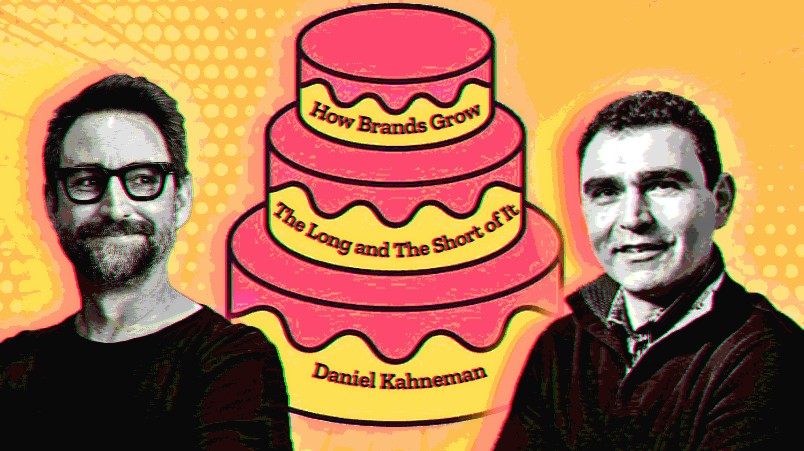
“It’s like baking a [marketing science] cake. Use all of the ingredients, it turns out brilliant. Leave any out, it's a mess.” James Hurman (left) and Douwe Bergsma are using every key marketing science ingredient – and watching KPIs rise nicely.
How an ex-P&G US marketer ditched cohorts, personas and restrictive segmentation, blended Ehrenberg-Bass, Binet & Field textbooks word for word, landed biggest marketing budget in $7bn company’s history – and all KPIs are powering
It’s not often Australian and New Zealanders can teach the giant US market a thing or two but hear this one out: If you're one of those hard-nosed types who think all this marketing science and advertising effectiveness stuff is too rubbery – ESOV, mental availability, investing in brand to drive long-term demand over short-term sales – here’s some contrarian proof that might just change your mind. It’s a textbook case from a CMO who took a giant leap and deployed a whole suite of marketing's new and established thinking in one strategic gulp, rolling it out across a $7bn US healthcare brand and sweeping away pretty much everything that had gone before. It worked, massively. All growth KPIs for Douwe Bergsma, CMO of Georgia-based healthcare firm Piedmont, are busting upwards and the CEO handed him the biggest marketing budget in the company’s history to do it. Here’s how Bergsma, a former P&G marketer and current ANA board member, along with NZ-based brand and start-up strategist James Hurman, hatched a plan to do everything by the marketing science and effectiveness handbooks, sold it into the leadership team, brought every single one of its agencies into 20 marketing effectiveness briefings – and literally ended up with a runaway best seller. It’s the story of a Dutchman and a Kiwi taking Australian and UK marketing science to the US, and winning big. An absolute must-listen – or read the article here first as a primer.


